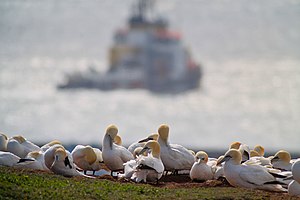
Back سلوك اجتماعي Arabic Comportament social Catalan Sozialverhalten German Socia konduto Esperanto Comportamiento social Spanish رفتار اجتماعی Persian Comportement social French Սոցիալական վարքագիծ (վարք) Armenian Perilaku sosial ID 사회행동 Korean

Social behavior is behavior among two or more organisms within the same species, and encompasses any behavior in which one member affects the other. This is due to an interaction among those members.[1][2] Social behavior can be seen as similar to an exchange of goods, with the expectation that when you give, you will receive the same.[3] This behavior can be affected by both the qualities of the individual and the environmental (situational) factors. Therefore, social behavior arises as a result of an interaction between the two—the organism and its environment. This means that, in regards to humans, social behavior can be determined by both the individual characteristics of the person, and the situation they are in.[4]
A major aspect of social behavior is communication, which is the basis for survival and reproduction.[5] Social behavior is said to be determined by two different processes, that can either work together or oppose one another. The dual-systems model of reflective and impulsive determinants of social behavior came out of the realization that behavior cannot just be determined by one single factor. Instead, behavior can arise by those consciously behaving (where there is an awareness and intent), or by pure impulse. These factors that determine behavior can work in different situations and moments, and can even oppose one another. While at times one can behave with a specific goal in mind, other times they can behave without rational control, and driven by impulse instead.[6]
There are also distinctions between different types of social behavior, such as mundane versus defensive social behavior. Mundane social behavior is a result of interactions in day-to-day life, and are behaviors learned as one is exposed to those different situations. On the other hand, defensive behavior arises out of impulse, when one is faced with conflicting desires.[7]
- ^ Suckow, Mark A.; Weisbroth, Steven H.; Franklin, Craig L., eds. (2006). The Laboratory Rat. ISBN 978-0-12-074903-4. Archived from the original on 2021-12-16. Retrieved 2021-09-13.[page needed]
- ^ Kastin, Abba J., ed. (2013). Handbook of Biologically Active Peptides. Elsevier Science. ISBN 978-0-12-385095-9. Archived from the original on 2021-12-16. Retrieved 2021-09-13.[page needed]
- ^ Homans, George C. (1958). "Social Behavior as Exchange". American Journal of Sociology. 63 (6): 597–606. doi:10.1086/222355. JSTOR 2772990. S2CID 145134536.
- ^ Snyder, Mark; Ickes, W. (1985). "Personality and social behavior". In Lindzey, G.; Aronson, E. (eds.). Handbook of Social Psychology. pp. 883–948. OCLC 567970783.
- ^ Robinson, Gene E.; Fernald, Russell D.; Clayton, David F. (7 November 2008). "Genes and Social Behavior". Science. 322 (5903): 896–900. Bibcode:2008Sci...322..896R. doi:10.1126/science.1159277. PMC 3052688. PMID 18988841.
- ^ Strack, Fritz; Deutsch, Roland (2004). "Reflective and impulsive determinants of social behavior". Personality and Social Psychology Review. 8 (3): 220–247. CiteSeerX 10.1.1.323.2327. doi:10.1207/s15327957pspr0803_1. PMID 15454347. S2CID 2847658.
- ^ Whiting, Beatrice Blyth (1980). "Culture and Social Behavior: A Model for the Development of Social Behavior". Ethos. 8 (2): 95–116. doi:10.1525/eth.1980.8.2.02a00010. JSTOR 640018.